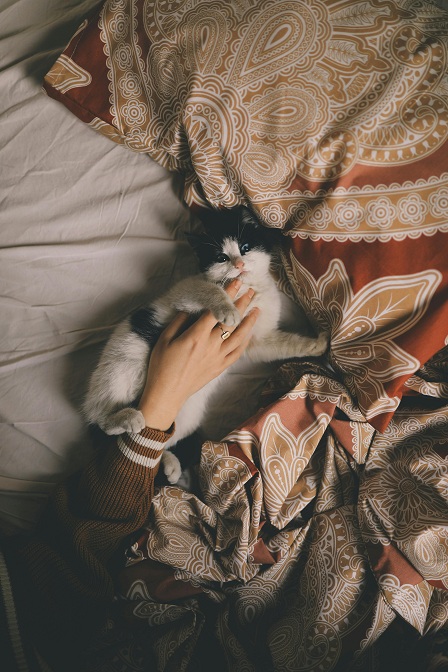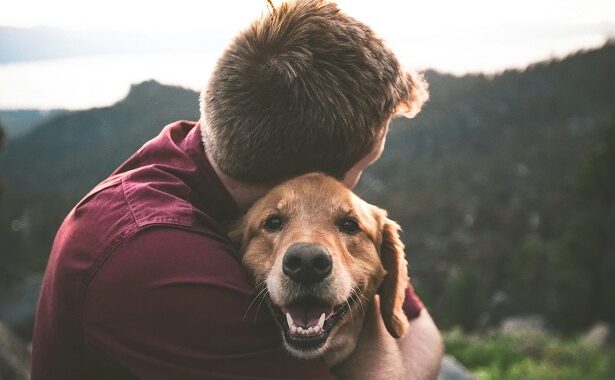How do you know your pet loves you? The bond between humans and their pets is a unique and powerful connection that transcends words. For pet owners, one of the most heartwarming experiences is realizing that their furry companions love them in return. While pets may not express affection in the same way humans do, there are distinct signs and behaviors that reveal their deep love and attachment.
Universal Signs of Pet Love Across All Animals
Physical Affection and Proximity
Pets show love through their desire to be close to you. Whether it’s a dog eagerly waiting at the door or a cat curling up in your lap, their presence speaks volumes.
One of the primary indicators that your pet loves you is their unwavering presence and desire for physical contact. This manifests in several ways:
- Unconditional Presence: Your pet consistently seeks to be near you, whether it’s a dog waiting eagerly at the door, a cat curling up in your lap, or a bird singing happily when you enter the room
- Cuddling and Snuggling: Pets display affection through physical closeness – seeking out your company, enjoying cuddling, or frequently sitting on your lap
- Physical Contact: Wet nose nudges, headbutts, leaning against you, or simply choosing to rest beside you are powerful indicators of emotional connection
Communication Through Body Language
Pets communicate volumes through their body language, and understanding these cues is crucial for recognizing their love:
- Eye Contact: Dogs and cats use eye contact to bond. Learn more about how to care for your pet cat to deepen this connection.
- Relaxed Body Language: A calm pet is a happy pet. If your pet is stressed, consider professional pet sitting services to ease their anxiety.
- Facial Expressions: Understanding your pet’s facial expressions and reciprocating with positive body language fosters a stronger emotional bond
Enthusiastic Greetings and Excitement
The way your pet greets you reveals a lot about their feelings:
- Joyful Reunions: The sheer excitement your pet displays upon your return home is a clear testament to their love – dogs may jump, bark, or wag vigorously, while cats might greet you with soft meows and playful behavior
- Greeting Rituals: Consistent greeting behaviors like bringing favorite toys, vocalizing, or weaving around your legs demonstrate genuine value for your presence
How Do You Know Your Pet Loves You?
The answer lies in their everyday actions. How do you know your pet loves you? From tail wags to purrs, pets communicate affection in ways that are easy to miss if you’re not looking closely. Here’s how to decode their love language.
12 Dog-Specific Signs of Love {#dog-signs}
Dogs, renowned for their loyalty and affectionate nature, express love through particularly recognizable behaviors. Here are the top 12 signs your dog loves you:
1. Tail Wagging Patterns
A joyful dog wags broadly! For high-energy pups, dog walking services can help them stay happy.
2. Excited Greetings
Does your dog go wild when you return? They adore you! If you’re away often, dog sitters can keep them company.
3. Eye Contact
Soft gazes mean trust. Strengthen your bond with interactive dog toys.
4. Following You Everywhere
A sign of loyalty. Ensure they’re comfortable with cozy pet beds.
5. Bringing You “Gifts”
Even socks count! Reward them with healthy dog treats.
6. Cuddling and Physical Closeness
Seeking out cuddles, leaning against you, or resting their head on your lap shows they want to be physically close to you.
7. Protective Behavior
Positioning themselves between you and potential threats demonstrates their devotion and willingness to keep you safe.
8. Licking (Dog Kisses)
Gentle licking is a sign of affection – it’s how dogs show love and bond with their favorite humans.
9. Responding to Your Emotions
Dogs that comfort you when sad or celebrate when you’re happy show remarkable emotional intelligence and deep connection.
10. Playful Interactions
Initiating games, bringing toys for play, and showing enthusiasm during interactive time indicates a strong, happy bond.
11. Sleeping Near You
Choosing to sleep in your presence or on your bed shows ultimate trust and security in your relationship.
12. Synchronized Routines
When your dog anticipates your schedule and becomes synchronized with your habits, it shows strong attachment and attention to you.
Cat-Specific Signs of Affection

Cats, though more independent, have their own unique ways of expressing love:
Feline Communication
- Purring & Kneading – A happy cat! Keep them content with catnip toys.
- Slow Blinking – “Cat kisses” mean trust. Learn more in cat care guides.
- Grooming You – They see you as family. Return the love with gentle brushes.
Physical Expressions
- Head Bonks and Rubbing: Cats mark you with their scent as a sign of ownership and affection
- Grooming: Attempting to groom you demonstrates acceptance and care
- Presenting “Gifts”: Bringing small items or prey shows their desire to provide for you
Signs Across Other Pets
Small Animals (Rabbits, Rats, Guinea Pigs)
- Grooming Behavior: Gentle licking or grooming shows trust and affection. explore pet nursing hotels.
- Comfortable Resting: Relaxing in your presence without hiding indicates security
- Eager Eating: Accepting treats from your hand demonstrates trust
- Playful Engagement: Active play and exploration in your vicinity suggests enjoyment
Birds
- Singing and Vocalizing: Happy chirping or singing when you’re present
- Approaching Cage Bars: Moving toward you when you’re near their habitat. A sign of joy! Enhance their habitat with quality bird cages.
- Accepting Touch: Allowing gentle petting or handling shows trust
Reptiles (Turtles, etc.)
- Responsive Behavior: Swimming toward you or showing interest in your presence
- Comfortable Basking: Remaining relaxed and not retreating when you’re nearby
- Recognition: Responding positively to your voice or presence over time
Protective and Playful Behaviors
Protective Instincts
Pets often develop strong protective instincts toward their loved ones:
- Alert Behavior: Barking, growling, or positioning themselves as barriers against perceived threats
- Vigilance: Staying alert to your safety and well-being in various situations
- Defensive Positioning: Strategically placing themselves between you and potential dangers
Playful Interactions
Play serves as a crucial bonding mechanism:
- Initiating Games: Bringing toys, initiating fetch, or playfully engaging with you
- Shared Activities: Eagerly participating in activities you both enjoy
- Joyful Expression: Displaying happiness and energy during interactive play sessions
How Pets Understand Your Love
While pets may not comprehend the abstract concept of love as humans do, they recognize and respond to actions that convey affection:
Physical Expressions
- Touch and Petting: Regular, gentle physical contact communicates warmth and security
- Quality Time: Dedicated time spent together strengthens bonds and shows commitment
- Consistent Care: Providing food, veterinary care, and comfort demonstrates love through actions
Emotional Communication
- Positive Voice Tone: Gentle, warm tones convey affection and reassurance
- Eye Contact: Soft, loving gazes communicate trust and connection
- Routine and Predictability: Consistent daily routines create security and show reliability
Recognition Signals
- Celebrating Achievements: Positive reinforcement for good behavior shows appreciation
- Understanding Individual Needs: Recognizing and accommodating personal preferences demonstrates attentiveness
- Providing Comfort: Offering support during stress or illness shows deep care
When to Be Concerned: Signs of Discomfort
While focusing on positive signs of affection, it’s important to recognize when a pet may be uncomfortable:
Warning Signs
- Avoidance or Hiding: Consistently retreating from interaction
- Stiff Body Language: Tense posture, rigid stance, or pinned-back ears
- Aggressive Behaviors: Growling, snapping, or defensive reactions
- Stress Indicators: Excessive panting, drooling, or displacement behaviors like lip licking
Health Considerations
Changes in affectionate behavior could indicate health issues, so it’s important to monitor your pet’s overall Pet Health and Wellness and consult professionals when needed.
Building and Strengthening the Bond
Communication Strategies
- Learn Your Pet’s Language: Understand their cues with pet behavior books.
- Respond Appropriately: Acknowledge and reciprocate their expressions of affection
- Be Patient: Allow relationships to develop naturally over time
- Routine Care: Consistent love matters. If you travel, pet sitting services can help.
Creating Positive Experiences
- Establish Routines: Consistent daily interactions build trust and security
- Respect Boundaries: Understand and honor your pet’s comfort levels
- Provide Safe Spaces: Ensure your pet has secure areas where they feel protected
Ongoing Relationship Development
- Stay Attentive: Continue observing and responding to your pet’s evolving needs
- Maintain Consistency: Regular care and attention reinforce your bond
- Celebrate the Connection: Appreciate and enjoy the unique relationship you share
Final Thoughts
Pets express love in countless ways. Whether you’re a dog lover, cat enthusiast, or small pet owner, nurturing this bond is priceless. For more resources:
- Pet adoption guides
- In-depth guide Pet Health and Wellness.
- Pet product recommendations
Read more:
- Scientific Studies on Pet Behavior:
American Veterinary Medical Association (AVMA)
- Pet Adoption & Rescue:
- Pet Training & Enrichment:
International Association of Animal Behavior Consultants (IAABC)
- Pet Health & Wellness:
The Cat Fanciers’ Association (CFA)
- Pet Product Reviews:
Frequently Asked Questions About Pet Love {faqs}
How do you tell if your dog actually loves you?
Genuine love from your dog shows through consistent tail wagging, joyful greetings, seeking physical closeness, following you around, making eye contact, and displaying excitement when you return home. These behaviors indicate a strong emotional bond.
What are the 5 signs that your dog loves you most?
- Tail wagging with relaxed body language
- Eye contact with soft, trusting gazes
- Physical affection like cuddling and leaning
- Excited greetings when you come home
- Following you and seeking your attention
Do pets know when you love them?
Yes, pets can perceive and understand love through your actions. They interpret physical affection, positive voice tones, consistent care, quality time, and routine as expressions of love and respond accordingly.
How do I know my dog loves me?
Look for tail wags, cuddles, and excitement! For more, read dog behavior guides.
Do cats feel love?
Absolutely! Their purrs and headbutts say it all. Need cat care tips? Check this guide.
How does your pet show love for you?
Pets show love through physical affection (cuddling, licking), excited greetings, seeking attention, playful behavior, protective instincts, and choosing to spend time near you. Each pet has unique ways of expressing affection.
Can you tell if other pets besides dogs and cats love you?
Yes! Rabbits show love through grooming behavior and comfortable resting, birds express affection through singing and approaching, rats demonstrate love through social behavior and gentle licking, and even reptiles can show recognition and comfort in your presence.
